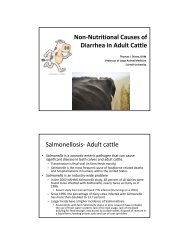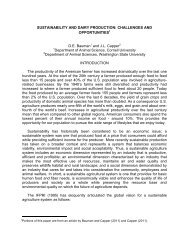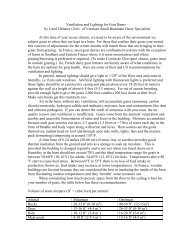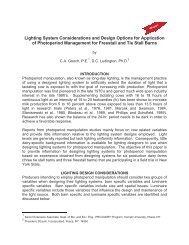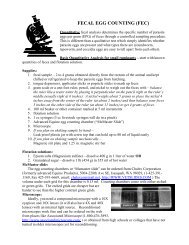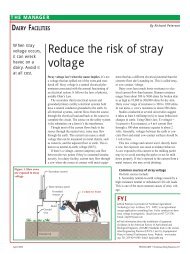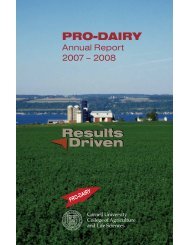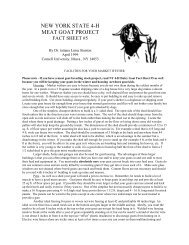2009 Proceedings of the Cornell Nutrition Conference For Feed ...
2009 Proceedings of the Cornell Nutrition Conference For Feed ...
2009 Proceedings of the Cornell Nutrition Conference For Feed ...
Create successful ePaper yourself
Turn your PDF publications into a flip-book with our unique Google optimized e-Paper software.
2002; Volden et al., 2002; Hedvquist and Uden, 2006; Reynal et al. 2007), thus, to<br />
account for <strong>the</strong> AA pr<strong>of</strong>ile <strong>of</strong> <strong>the</strong>se peptides, we need to provide an AA pr<strong>of</strong>ile for <strong>the</strong><br />
soluble pool. This is currently being done by ma<strong>the</strong>matical manipulation <strong>of</strong> <strong>the</strong> pools<br />
and rates but a more robust approach is needed to account for more variation in <strong>the</strong><br />
predicted AA flow.<br />
Amino acid supply from protozoa<br />
The CNCPS does not have a protozoa pool within <strong>the</strong> rumen submodel, however it<br />
is now known that from 5% to at least 20% <strong>of</strong> <strong>the</strong> total AA flows from <strong>the</strong> rumen are<br />
from <strong>the</strong> protozoa (Shabi et al., 2000; Sylvester, et al. 2005; Karnati et al., 2007). The<br />
CNCPS currently calculates that <strong>the</strong> protozoa consume 20% <strong>of</strong> <strong>the</strong> estimated bacterial<br />
yield, thus <strong>the</strong> Ymax estimation is reduced from 0.5 g <strong>of</strong> bacteria per g <strong>of</strong> carbohydrate<br />
per hour to 0.4 g. However, <strong>the</strong>re is really no provision for <strong>the</strong> ultimate fate <strong>of</strong> this<br />
bacterial growth and results in an estimate <strong>of</strong> bacterial yield that is static and ignores<br />
protozoa metabolism and any AA yield from <strong>the</strong> protozoa. There are enough data<br />
available from <strong>the</strong> work <strong>of</strong> Jeff Firkins group and many studies prior to that to engage in<br />
a remodeling <strong>of</strong> <strong>the</strong> rumen submodel to include <strong>the</strong> protozoa and develop a true<br />
microbial growth model that <strong>the</strong>n drives yield based on <strong>the</strong> liquid and solid passage<br />
rates. This would be a very different rumen submodel than we currently have and would<br />
allow for <strong>the</strong> development <strong>of</strong> a volatile fatty acid model which is needed if we are to<br />
effectively predict <strong>the</strong> substrates available for milk production that differentiates how <strong>the</strong><br />
cow utilizes those nutrients. Some <strong>of</strong> this will be addressed by Recktenwald and Van<br />
Amburgh in during this conference.<br />
It is important to recognize that protozoa have a different AA pr<strong>of</strong>ile, especially with<br />
respect to methionine and lysine. The methionine content <strong>of</strong> protozoa is lower than that<br />
<strong>of</strong> bacteria (24.0 vs 28.4 g/kg <strong>of</strong> total AA, whereas <strong>the</strong> lysine content <strong>of</strong> protozoa is<br />
significantly greater than bacteria (121.4 vs 90.3 g/kg total AA) (Shabi et al., 2000). This<br />
suggests that under certain formulation conditions, if protozoa were included in <strong>the</strong><br />
prediction <strong>of</strong> AA flow, lysine might not be as limiting an AA provided protozoal growth<br />
and escape made up a significant portion <strong>of</strong> <strong>the</strong> MP supply. Protozoa are lower in<br />
BCAA content, thus potentially creating conditions where those AA are more limiting.<br />
Absorbed Amino Acids – Efficiency <strong>of</strong> Use<br />
Coefficients for <strong>the</strong> efficiency <strong>of</strong> individual AA use for pregnancy and lactation have<br />
been updated from <strong>the</strong> original values provided in O'Connor et al. (1993). The revised<br />
coefficients for <strong>the</strong> efficiency <strong>of</strong> individual AA use for lactation were calculated from<br />
summarized data for uptake/output <strong>of</strong> individual AA by <strong>the</strong> mammary gland in<br />
experiments using dairy cattle (Cant et al., 1993; Clark et al., 1977; Erickson et al.,<br />
1992; Guinard and Rulquin, 1995; Hanigan et al., 1992; Lykos and Varga, 1997; Mackle<br />
et al., 2000; Metcalf et al., 1996; Spires et al., 1975).<br />
Efficiency factors for use <strong>of</strong> individual essential AA that are utilized in CNCPS are<br />
provided in Table 1. Of note is <strong>the</strong> substantial standard deviation associated with <strong>the</strong><br />
31



